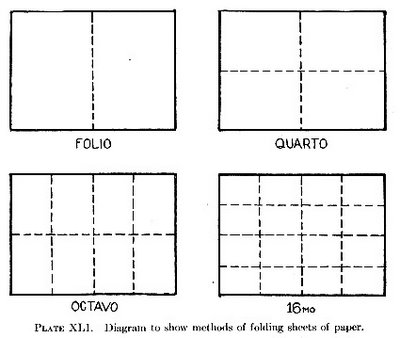
The traditional terms for describing book formats are derived from early printing methodology and the size of early handmade sheets of paper.
Paper Sizes: the most common names for the original size of paper from which the formats described below were created are:
· Imperial (30 in. by 22 in.)A sheet, when folded, has twice as many pages as leaves, for the obvious reason that it is printed on both sides, the number of leaves depending on the size of the original sheet and the way in which it is folded.
· Royal (25 in. by 20 in.)
· Demy (22 ½ in. by 17 ½ in.)
· Crown, cr (20 in. by 15 in.)
· Foolscap, fcp (17 in. by 13 ½ in.)
· Pott (15 in. by 12 ½ in.)
 When two leaves (four pages when printed on both sides) were printed on a sheet so that it could be folded once, collated with other folded sheets and bound, the format of the volume was a "folio". When four leaves (eight pages) were printed on the same size sheet, which would later be folded twice, the format of the resultant volume was a "quarto" (four leaves). The term "octavo" relates to the sheet having eight leaves printed on it. The octavo is the most general size of a book, and the printed text is so arranged that, when the sheet is folded, the sixteen pages follow consecutively (see illustration). This folded printed sheet of leaves prior to binding is called a gathering. After binding it is referred to as a signature.
When two leaves (four pages when printed on both sides) were printed on a sheet so that it could be folded once, collated with other folded sheets and bound, the format of the volume was a "folio". When four leaves (eight pages) were printed on the same size sheet, which would later be folded twice, the format of the resultant volume was a "quarto" (four leaves). The term "octavo" relates to the sheet having eight leaves printed on it. The octavo is the most general size of a book, and the printed text is so arranged that, when the sheet is folded, the sixteen pages follow consecutively (see illustration). This folded printed sheet of leaves prior to binding is called a gathering. After binding it is referred to as a signature.Today some booksellers are providing the height of a book in inches or centimeters rather than using these early terms which do not relate directly to the sheet size or process used for printing today. The following is a guide to convert book formats to approximate book sizes:
· Folio: more than 13 inches tallThere are smaller and larger books, i.e. many miniatures are 64mo. Most hard bound books today are either octavo or duodecimo in size.
· Quarto (4to): approx. 10 to 13 inches tall, average 12 inches
· Octavo (8vo): approx. 8 to 10 inches tall, average 9 inches
· Duodecimo (12mo): approx. 7 to 8 inches tall, average 7.5 inches
· Sextodecimo (16mo): approx. 6 to 7 inches tall, average 6.5 inches
For definitions of other commonly encountered book terms see Glossary of Terms.

2 comments:
Why is the opposite of the spine of a book ( the long edge of the pages) on some books not even?
I find it very irritating as this wavy edge makes it hard to flip the page.
I'm told this is also called deckle edge.
Thanks.
You don't say how old the book is or if the edge is a true deckle or deckle-like. A true deckle edge is one created in the process of making a sheet of paper. The pulp naturally thins at the edge of the mould in which the paper is made. A deckle-LIKE edge is created by tearing paper along a fold.
Many old books were bound and sold with paper folds untrimmed. It was up to the reader to cut them with a paper knife, similar to a letter opener, thus causing a slightly irregular, deckle-like edge. A sheet folded in quarto would have folds at the spine and also across the top, so the top folds would have to be cut before the pages could be turned. A signature folded in octavo or greater might require that the other two sides be trimmed. If a true deckle paper was used, depending on the book format, the page edges might be deckled or be a combination of deckle and deckle-like.
Some publishers today published books with faux deckle edges for those who appreciate the beauty of the rough-cut edge. While considered an asset by some, it is considered an affectations by others.
Post a Comment